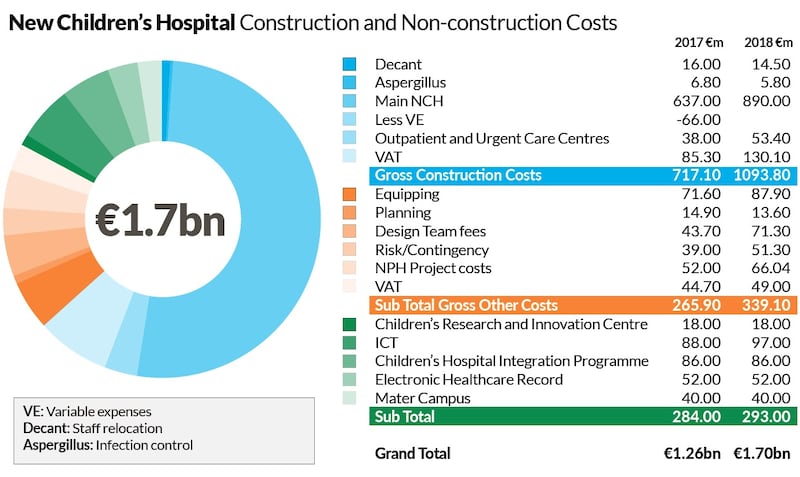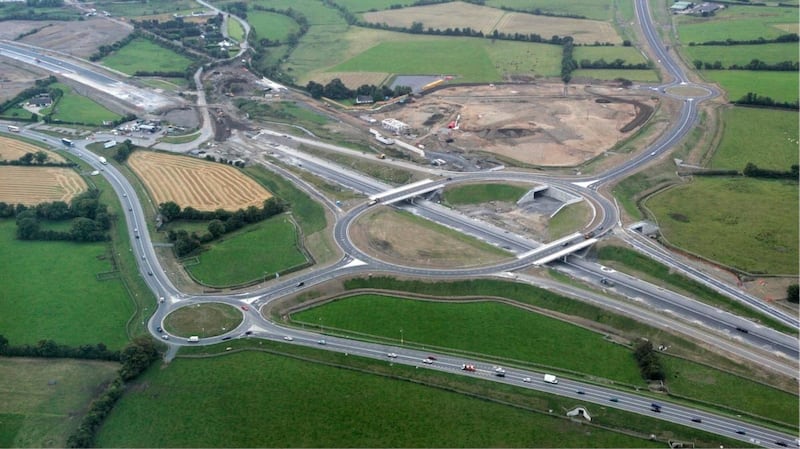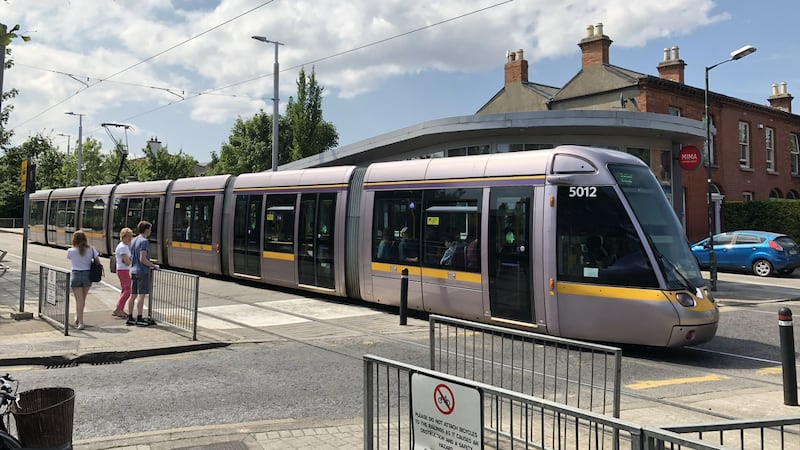When examining Ireland’s long, unenviable list of infrastructure projects that cost far more than expected, a pattern emerges.
The department, minister or agency which evaluates the project is often the one most determined that it proceed.
This creates a conflict of interest which is the core of many subsequent, costly problems, according to an expert in this area, Edgar Morgenroth, professor of economics at DCU Business School.
An incentive to underestimate costs at evaluation stage can be created, just to get the project started, he says. “That’s what you find internationally.”
The evaluation of projects “should not be done by people who propose the projects. You cannot be gamekeeper and poacher at the same time,” he says.
Massive overspending on big public projects is not unusual internationally, but Ireland has rare form in this regard. The motorway network, Luas, the national broadband plan, the Health Service Executive’s PPARS (personnel, payroll and related systems) computer system, the Dublin port tunnel and now the national children’s hospital projects all saw huge increases beyond the initial cost.
Bent Flyvbjerg, a professor at Oxford University, has researched “mega-projects” undertaken by governments internationally and has found massive overspending is a feature in 90 per cent of major public projects.
In a paper on this subject he said the “iron law” of public mega-projects is they are “over budget, over time, over and over again”.
Project management
Why does this keep happening? Prof Flyvbjerg says it is because of the intersection between politics and project management.
A political desire to do something unique leads time and again to initial costs being underestimated and to benefits being overestimated, followed by a subsequent determination to keep going despite rising costs, he says.
Prof Flyvbjerg quotes a former mayor of San Francisco on persistent overspending on major transport projects: “The idea is to get going. Start digging a hole and make it so big there’s no alternative to coming up with the money to fill it in.”
This is where Ireland finds itself with the children’s hospital: the “big hole” stage.
In 2016, then minister for heath Leo Varadkar said the children’s hospital would be completed by 2020, “short of an asteroid hitting the planet”.
The estimated cost then of €670 million bears no relation to the current reality, where the final cost is set to top €1.7 billion.

Faced with abandoning, retendering or continuing with the project, Minister for Health Simon Harris has decided the least worst option is to keep going.
Prof Morgenroth has identified another recurring problem for public infrastructure projects: an incapacity to evaluate risk.
With public projects there is an assumption that there will be no problems and no delays. Despite this optimism, “things can go wrong [but] how are contingencies costed?
“Insufficient allowance is made for these kinds of risks.”
And then there is always the danger of design creep, “where a public objection may get politician to force changes in design,” he adds.
Design changes
There are many examples of this, including the Metro project, first mooted back in 2002, with a projected budget of €2.4 billion.
Now the much-changed Metrolink has a budget of €3 billion but has been stalled by controversy over where the underground line will join with the Luas green line. Design changes on this issue alone could add up to €35 million to the project.
Design changes and delays also contributed to the cost of the Dublin port tunnel escalating from €450 million to €750 million.
Prof Morgenroth also notes the required expertise to manage projects of this scale is simply not available in most departments.
“Expertise [in procurement and cost projection] is something that has definitely been lacking,” he says. “You will find it in agencies like the National Treasury Management Agency, where they are dealing with public-private partnerships.”
Frustratingly, the points raised by Prof Morgenroth and Prof Flyvbjerg are not new.
In 2004, the then comptroller and auditor general (C&AG) John Purcell investigated the State’s motorway programme to find out why it had cost €16 billion instead of the €5.6 billion forecast, and why half the new roads lagged badly behind deadline.
Purcell found the initial cost was underestimated by 40 per cent, due to a systematic failure to fully cost parts of the projects “and a failure to fully take into account construction inflation”.
His report identified a lack of costing expertise, not using fixed-price contracts (so cost increases were borne by the State) and consultants who were paid a percentage of the overall cost – removing the incentive to finish early.

There was also design creep, where politicians or officials added extra elements which led to knock-on costs and a succession of planning appeals. All added cost.
“The problem in the old days was that a lot of projects were announced and somebody made a guess at that very early stage,” says Noel Dempsey, the former minister for the environment.
Dempsey recalls the N11 route was held up for up to five years because of objectors at the Glen of the Downs.
Similarly, the M7 was delayed to protect a rare snail, the Angistora vertiego, the habitat of which was Pollardstown Fen.
Following that C&AG report, the National Roads Authority (NRA) changed its contracts to fixed-price contracts and recruited people with the required expertise.
Dempsey says after the NRA took control of all major road projects from local authorities, cost estimates, value for money and hitting deadlines improved.
Value for money
The intangible is value for money, especially in the absence of a public cost benefit, as is the case with the children’s hospital.
A person with deep knowledge of the hospital project, who spoke on condition of anonymity, is certain that even at €1.7 billion this hospital, with its 160,000sq m, 6,000 rooms (including 400 en-suite rooms for children) and state-of-the-art facilities, will represent value for money.
Other countries are building cheaper, although smaller, hospitals for children.
In Helsinki the new children’s hospital will cost €150 million; in Copenhagen €350 million; and in Edinburgh about €210 million.
However, this person says the best comparator is the new children’s hospital in Adelaide, which has a similar overall cost to the national children’s hospital.
But Prof Morgenroth disagrees. Even with a higher specification and a larger size, he says, the cost of Ireland’s new hospital remains a multiple of the others and he does not think it represents good value for money.
For taxpayers, the context to this political debacle is Project Ireland 2040, in which the Government proposes spending €116 billion on infrastructure projects over the next two decades.
If this pattern of poor initial cost estimates and a failure to adequately account for risk continues then the State will get far less in return for this investment than it expects.

CASE STUDIES
National stadium
The idea for a 80,000-seat stadium and a campus in Abbotstown in west Dublin was a pet project for then taoiseach Bertie Ahern in the 1990s.
The initial cost estimate was €200 million but this started rising from day one and by the time the project was abandoned in 2002, the estimated cost had hit €880 million. When it was abandoned costs of €200 million had been incurred. This included the moving the State laboratory to the site and building the National Aquatic Centre at a cost of €61 million.
Motorways
The massive gap between estimate and reality in the State’s motorway programme was exposed in 2004. The programme was expected to cost €5.6 billion, but the final bill was €16.4 billion.
The C&AG said initial estimates understated construction inflation and he pointed out that this was foreseeable. The early contracts also were not fixed price, meaning cost increases were borne by the State.
Luas
When Luas got the go-ahead it was a €200 million project due to be finished by 2001. Green-lit by then minister Michael Lowry in 1996, the plans were subject to interference and change by a succession of ministers. The upshot was design changes and lines that did not meet. The completion date was pushed back to 2003, then to 2004, by which time the bill was €778 million. As an example of learning from mistakes, the Luas extension project, which linked the two lines and extended the green line to Broombridge, came in on budget and on time.
PPARS
PPARS started off in 1997 as a straightforward project to upgrade the HSE’s payroll system at a cost of €9 million. But those behind the project did not fully comprehend the complexity of the challenge and by the time the C&AG investigated the system the costs had ballooned to €130 million. The system once paid an employee €1 million for two weeks’ work. The project was abandoned in 2005.













